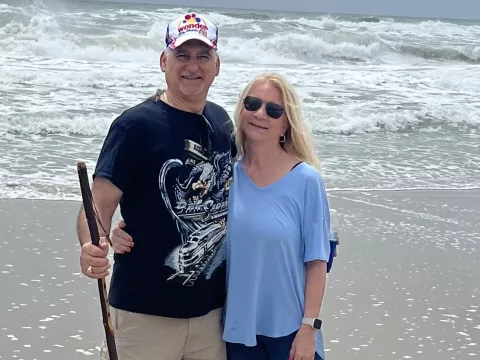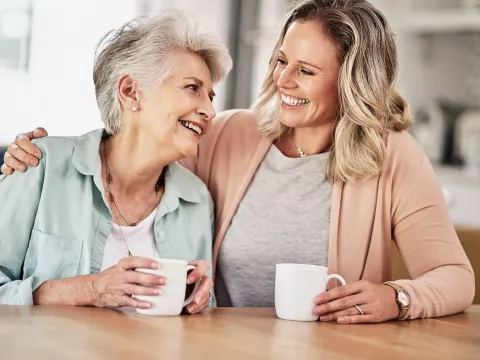- AdventHealth Shawnee Mission

Choose the health content that’s right for you, and get it delivered right in your inbox.
As a cardiac nurse who is now the regional executive director for Heart and Vascular Services at AdventHealth, Vickie Franck knows what to do in a cardiac emergency. In fact, she’s administered CPR many times within the hospital on patients of various ages. She was also the first responder on the scene of someone in cardiac arrest outside of the hospital in three different instances. The first was a gentleman on the side of a highway; the second was a young woman; and the third was Vickie’s husband. She never expected to perform CPR on a loved one. Until it happened.
Vickie’s husband, Dan, is a musician who records a variety of music genres, including contemporary Christian, blues and, most recently, Jimmy Buffet style music. Dan was traveling to Springfield, Missouri, to a recording studio. It was not an uncommon occurrence and Vickie normally didn’t go along on these trips. However, she decided to go this time and take the opportunity to see her grandchildren.
It was early morning and Vickie heard a noise in the hotel bathroom. She found her husband leaning over the counter. He was conscious and told Vickie he thought he passed out. Vickie said he was extremely pale, as she grasped his face with her hands, he suddenly slumped over and was in full cardiac arrest.
“I guided him to the floor the best I could,” said Vickie. “His color was gray and his eyes were fixed and glazed over. I quickly assessed that he wasn’t breathing and didn’t have a pulse. In that moment, I threw open the hotel door hoping someone was in the hall to call for help. But there was no one, so I flipped open the door latch, dialed 911 and started CPR. It was the scariest moment in my life.”
Vickie started hands-only CPR, administering compressions for about three to five minutes. Then, she started rescue breathing.
“Honestly, it was like God breathed life into his lungs,” said Vickie. “He became responsive just as the paramedics showed up. We had a very good outcome. Had I not been with him or did not know how to perform CPR, my husband would have died and my grandkids would not have Grandpa Dan or as one granddaughter calls him ‘her Papa’, and his mom would have lost another son.”
According to the American Heart Association, more than 70 percent of out-of-hospital cardiac arrests happen in homes and about 40 percent of those who experience an out-of-hospital cardiac arrest receive the help needed before emergency professionals arrive. Knowing hands-only CPR can make a life or death difference for those you love.
So what exactly is hands-only CPR? Simply put, hands-only CPR is chest compressions. Hands-only CPR is easy for anyone to learn and has proven to be as effective as traditional CPR in those first few minutes during a cardiac arrest emergency.
The American Heart Association explains hands-only CPR as two simple steps. First, call 911 if you see someone suddenly collapse. Second, start chest compressions. Push hard and fast in the center of the person’s chest at the rate of 100 to 120 beats per minute.
One way to know you have the correct compression rate is to use a familiar song, such as “Stayin’ Alive” by the Bee Gees, as a guide.
According to the AHA, only one in 10 people survive an out-of-hospital cardiac arrest, so increasing the amount of people who know hands-only CPR is critical.
“Hands-only CPR can double survival odds,” said Vickie. “As scary as the situation may be, knowing how to do CPR may make the difference in someone living or dying.”
Although we know the importance of learning how to administer CPR, many people are still not trained and four out of ten adults are reluctant to use CPR in an emergency situation.
Vickie believes there are many reasons why more people are not trained in hands-only CPR. It may be due to lack of access to training or concerns about performing CPR incorrectly.
“The reality is you are not going to hurt an individual who is lifeless or clinically deceased,” said Vickie. “But you can save their life by learning this simple, easy skill that you will remember for a lifetime.”
You can make a difference in someone’s life by learning hands-only CPR. For more information or to find a class near you, visit cpr.heart.org.



